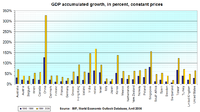
Photo from wikipedia
Abstract In this paper we discuss an original article by Gales et al. (2007) concerning the relationship between total energy intensity and GDP per capita. In their chiefly descriptive analysis… Click to show full abstract
Abstract In this paper we discuss an original article by Gales et al. (2007) concerning the relationship between total energy intensity and GDP per capita. In their chiefly descriptive analysis of four European countries (Sweden, the Netherlands, Italy and Spain) over the last two centuries, no inverted U-curve relationship was found between total energy intensity (sum of traditional and modern energy sources) and GDP per capita. By contrast, in addition to considering total energy intensity we also distinguish between modern energy intensity and traditional energy intensity. Further, we integrate qualitative analysis with empirical analysis (i.e., the ARDL cointegration procedure) in order to make our results more robust. The main conclusions of Gales et al. (2007) are only partially confirmed: considering total energy intensity can lead to erroneous conclusions. In particular, our estimates show a U-shaped relationship between total energy intensity and GDP per capita. In addition, when we decompose total energy intensity, two different relationships emerge: a hyperbolic pattern (traditional energy carriers) and a U-shaped inverse pattern (modern energy carriers). We conclude that the decreasing branch of the U-shaped relationship between total energy intensity and GDP per capita is driven by traditional energy sources when the latter dominate modern energy sources (low levels of GDP per capita). In contrast, the ascending branch of the U-shaped relationship is driven by modern energy sources when prevailing over traditional sources (high levels of GDP per capita).
Journal Title: Energy Economics
Year Published: 2019
Link to full text (if available)
Share on Social Media: Sign Up to like & get
recommendations!